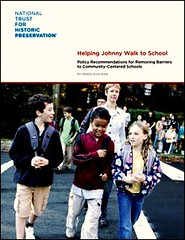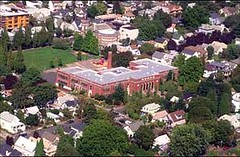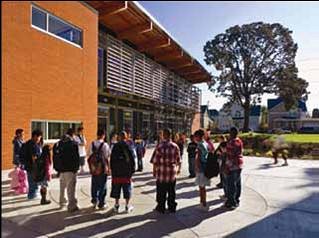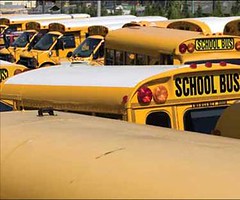The walk of life – helping Johnny (and Joanie) walk to school

Posted March 31, 2010 at 1:38PM
“Aside from reduced CO2, less traffic time and health advantages, the most important benefit of walk to school programs is teaching children self-reliance.”
The quote comes from architect and urbanist Ann Daigle, who puts into practice all the things that this blog advocates. And it’s a fitting intro to telling you about the National Trust’s important new report, Helping Johnny Walk to School.  The report is a sequel to the Trust’s seminal Why Johnny Can’t Walk to School, co-authored by my friend Constance Beaumont and published in 2002.
The report is a sequel to the Trust’s seminal Why Johnny Can’t Walk to School, co-authored by my friend Constance Beaumont and published in 2002.
Helping Johnny Walk stresses policy recommendations and new ways (in many cases older but now under-appreciated ways) of thinking about the role of schools in our communities. I’ve written extensively on the blog about school sprawl, where some isolated newer schools are within walking distance of nobody, occupy lots twice as big as Disneyland, and are designed so that you can’t tell one from a Walmart, other than through signage and the presence or absence of shopping carts. (See, for example, here, here, and here.) Schools should be community anchors, not drains.
The new report is authored by Renee Kuhlman, who graciously gives credit to her able partners in the task. She introduces the report in a blog post:
“A school’s location has ripple effects on everything from the health of a local neighborhood to the health of its citizens. Consider this: moving a school to the outskirts of town typically means the loss of an older or historic school building, less public and private investment in a neighborhood, and lower property values. Not to mention the longer travel distances that increase the number of auto and bus trips, which in turn raise greenhouse gas emissions and busing costs.
“But what about our kids? How are they affected by outskirts schools? Think of it this way – if a school is located miles and miles from the residents it serves, few students can walk or bike.
With so much concern these days focused on childhood obesity, we cannot overlook this simple fact. The American Academy of Pediatrics certainly did not; in 2009, this esteemed group found that school location has ‘played a significant role in the decreased rates of walking to school, and changes in policy may help to increase the number of children who are able to walk to school.’”
The report stresses the many benefits of community-centered schools. Here’s an excerpt:
- Community-centered schools encourage close ties with community members. Because community-centered schools are used by residents of all ages for recreation and events during non-school hours, improvements are likely to be supported through local bond measures. These schools also provide more opportunities for interaction between students, teachers, and parents because long distances are not a barrier.
- Community-centered schools offer educational benefits. Since community-centered schools are located within neighborhoods, they often have a small student body. Studies have shown that smaller-sized schools see more students graduate,
 have better attendance records, and experience strong participation by students in extracurricular activities.
have better attendance records, and experience strong participation by students in extracurricular activities. - Community-centered schools increase property values. The presence of a local school supports higher property values and encourages continued public and private investment in the neighborhood. This in turn reinforces the tax base available to the schools.
- Community-centered schools save on construction and operating costs. By co-locating or sharing such facilities as libraries, theaters, athletic fields, swimming pools, and parks with non-school entities, both construction and operating costs can be lowered. Furthermore, renewing a school campus often costs less than purchasing a new site, mothballing or demolishing the original school, and constructing a new facility and supporting infrastructure.
- Community-centered schools offer location efficiency. Community-centered schools keep travel distances short. Shorter and fewer auto and bus trips help to reduce greenhouse gas emissions, save on busing costs, and lower the number of traffic collisions. Community-centered schools are also accessible by several modes of transportation, including such low carbon modes as walking and biking.
 Community-centered schools help the environment. Community-centered schools take advantage of existing resources, including roads, infrastructure, and buildings. Also renovating an existing building reduces waste intended for landfills and means less land is used on the outskirts of a community. The construction and operation of buildings account for 48 percent of the United States’ greenhouse gas emissions. But reusing and retrofitting existing buildings can reduce these emissions dramatically.
Community-centered schools help the environment. Community-centered schools take advantage of existing resources, including roads, infrastructure, and buildings. Also renovating an existing building reduces waste intended for landfills and means less land is used on the outskirts of a community. The construction and operation of buildings account for 48 percent of the United States’ greenhouse gas emissions. But reusing and retrofitting existing buildings can reduce these emissions dramatically.- Community-centered schools encourage healthier families. Schools in residential areas allow children and their families to get more exercise. Florida researchers found a higher rate of walkability for schools built prior to 1950 and for those built after 1996 when the state started requiring school districts and local planning agencies to coordinate land-use decisions. During these times, schools were built within or near residential districts which gave residents multiple ways they could travel to school.
Sprawling schools, by contrast, create myriad problems, including increased traffic, reduced opportunities for exercise,  weakened community ties, disinvestment and property value decline when older schools are abandoned, and higher taxes. The causes of school sprawl are just as plentiful, from inflexible minimum acreage and building size requirements that essentially legislate walkable schools out of existence, to funding formula biases, to concerns about whether older buildings can be rehabbed to address safety issues (most of them can), to incomplete cost-benefit calculations, and more. These are addressed point-by-point in the report with “action steps” to help remove barriers to neighborhood-based schools.
weakened community ties, disinvestment and property value decline when older schools are abandoned, and higher taxes. The causes of school sprawl are just as plentiful, from inflexible minimum acreage and building size requirements that essentially legislate walkable schools out of existence, to funding formula biases, to concerns about whether older buildings can be rehabbed to address safety issues (most of them can), to incomplete cost-benefit calculations, and more. These are addressed point-by-point in the report with “action steps” to help remove barriers to neighborhood-based schools.
Highly recommended.
Just after I learned of the Trust’s new report, I was heartened to see at least one school district take some aggressive remedial action. In direct contrast to the school in upstate New York that (until embarrassment led to a change) actually banned walking or cycling to school, an elementary school in Milton, Ontario, near Toronto, has done the opposite: it is now a “walking-only” destination (bikes and scooters are OK, too). Writing on Streetsblog, Sarah Goodyear quotes her Toronto correspondent:
“The Halton School Board’s Active and Safe Routes to School and local public health officials launched the program this year at Milton’s P.L. Robertson Elementary School. Costing the school board $125,000, the ban on driving is a one-year pilot with hopes of expanding to other schools in the community in the coming years.
“So far the project has been a success, with project manager Jenifer Jenkins saying that the school quickly reached a 100% compliance rate. Surprisingly the rate stayed high even as the weather worsened, indicating a broader change in behavior. Jenkins also says that some students who qualify for buses have opted to walk instead so as to join their friends. This implies that walking will become more attractive to students as more of their peers do start doing it.”
As Goodyear writes, “A little-mentioned side benefit of encouraging kids to travel to school using their own power is that it will get parents out of cars as well.” While I can see reasons for exceptions here and there, and I would be willing to bet that the school allows them, this is terrific. Of course, you need a walkable school to begin with in order to make it work, and that's where the Trust's recommendations come in.
(Now cue Dire Straits: "Hand me down my walking shoes/Here comes Johnny with the power and the glory . . . He do the walk, he do the walk of life . . .")